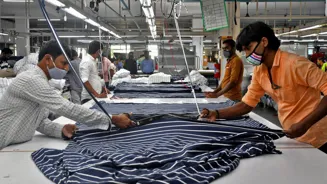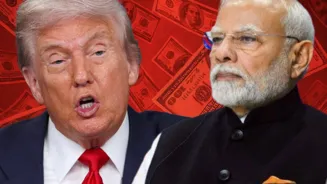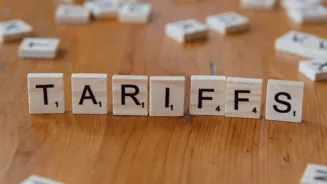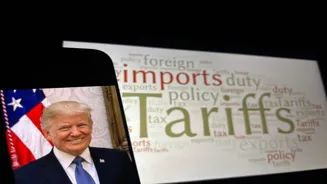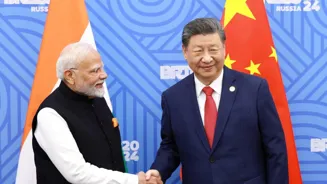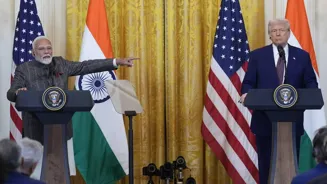Despite pressure from the US, New Delhi has remained defiant. The Central government is taking measures to shield Indian exporters from the steep 50 per cent tariffs on goods shipped to America.
Let’s take a closer look.
Trump’s 50% tariffs on Indian goods
The Trump administration’s high taxes on Indian exports to the US will affect $60.2 billion worth of goods, particularly labour-intensive sectors like textiles, gems and jewellery, shrimp, sporting goods, chemicals, carpets, footwear, and furniture.
For now, pharmaceuticals, electronics and petroleum products are exempted from the sweeping tariffs.

A craftsman checks the grading of polished diamonds in the grading department of a diamond processing unit in Surat, April 3, 2025. File Photo/Reuters
India shipped $86.51 billion worth of goods to the US in the year ended March 2025, as per official data.
Moody’s Analytics has predicted that the 50 per cent tariffs on Indian exports can reduce India's gross domestic product (GDP) for 2025 by 0.7 per cent.
“We think that the announced tariffs will reduce 2025 GDP growth by 0.3 per cent. Some of this is also due to lower global growth and higher uncertainty. However, if tariffs ratchet up to 50 per cent, the reduction in India’s GDP will be greater and could be as high as 0.7 per cent,” Gaurav Ganguly, Head of International Economics, Moody's Analytics, told Fortune India.
A day before Trump’s 50 per cent tariffs kicked in, gems and jewellery exporters approached the Reserve Bank of India (RBI) to seek its help to
The traders have also contacted US legal and business experts for advice on rerouting shipments through other nations that have lower tariffs, such as Turkey and Mexico.
Exporters said textiles and apparel manufacturers in Tirupur, Noida, and Surat have halted production as they face worsening competition from lower-cost rivals from Vietnam and Bangladesh.
“As for seafood, especially shrimps, since
How India is protecting its exporters
India has not bowed to the US pressure and hurried into a bilateral trade agreement (BTA). Instead, New Delhi is working on bringing deeper economic reforms to protect its traders from the steep US tariffs.
Goods that fall into the current 12 per cent and 28 per cent brackets will be pushed into these lower slabs.
A special rate of 40 per cent will be levied on select items such as ultra-luxury cars and “sin goods” like pan masala, gutkha
The GST reforms are expected to boost domestic consumption by leaving more money in people’s pockets, by lowering tax rates on essential goods. The GST cuts will give a fillip to the GDP growth by 0.6 per cent as per estimates, softening some of the tariff blow.
According to an SBI Research Report, the proposed GST reforms will enhance consumption by Rs 1.98 lakh crore.
The “next-gen reforms” also include policy adjustmentsto reduce business compliance expenses and do away with unnecessary
As per a Bloomberg report, a government report published this year showed that some factory regulations make running two facilities with 150 workers each more cost-effective than operating a single unit with 300 employees.
PM Modi has set up two high-level committees to determine policy adjustments. One panel will focus on state-level deregulation, while the other will create proposals for the next-generation reforms highlighted by the PM, Bloomberg reported.
RBIgovernor Sanjay
"This is an important area on which RBI has been working for a long time. It's important for countries to develop trade in local currencies. And so the RBI has also been moving in this direction. Today, we have agreements with four countries: the Maldives, Mauritius, Indonesia and the UAE, and trade is starting. It has certainly helped industry and the economy as
The Centre is also exploring extending financial assistance to exporters to soften the blow from the tariff hit. Senior officials from the Prime Minister's Office, along with representatives from commerce and finance ministries, are mulling potential solutions, including reduced-interest financing and aid in shifting to alternative markets, Times of India (TOI)reported, citing
The Indian traders are already bearing the brunt of the high US tariffs. "The US customers have already stopped new orders. With these additional tariffs, the exports could come down by 20-30 per cent from September onward," Pankaj Chadha, president, Engineering Exports Promotion Council, said, as per the newspaper.
Chadha apprised that the Central government is considering monetary assistance, comprising increased subsidies for bank borrowings and support for market diversification to mitigate potential
India is also diversifying its trade to reduce its reliance on the US. It has signed a Free Trade Agreement (FTA) with the United Kingdom, and is in advanced talks with the European Union (EU) and Russia.
These markets could be an alternative destination for India’s goods, helping New Delhi de-risk from the US.
A government official told PTIthat with the European Union, "we are fast-tracking our negotiations”. Trade talks have concluded with Oman and a deal is expected to be signed on mutually decided
With the 10-nation Asean bloc, India is holding review negotiations to reach a Free Trade Agreement.
India and the Russia-led Eurasian Economic Union (EAEU) recently signed the Terms of Reference (ToR) in Moscow to begin talks on a Free Trade Agreement.
As New Delhi and Beijing warm ties, India can also explore untapped export potential with China, which is estimated at $161 billion, as per a study by ICRIER.
ALSO READ: Textiles, gems, seafood: Sectors that will be hardest hit by Trump's 50%
India’s economy remains strong
India’s economy is resilient despite the US tariff shocks.
S&P Global Ratings recently revised India's sovereign rating to 'BBB' with a stable outlook, a first in 18 years. India's economy is predicted to remain the fastest-growing major economy in the world.
The country's manageable debt levels, strong forex reserves and contained current account deficit further insulate it from external shocks.
As per S&P Global Ratings, the steep US tariffs are not likely to impact
The United States is India's largest export destination, while private consumption makes up
The Ministry of Commerce and Industry is also reportedly planning a Rs 25,000-crore Export Promotion Mission, which will include trade finance, non-trade finance dealing with regulation, standards and market access, and so on.
With inputs from agencies
